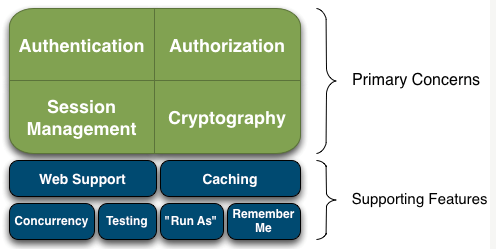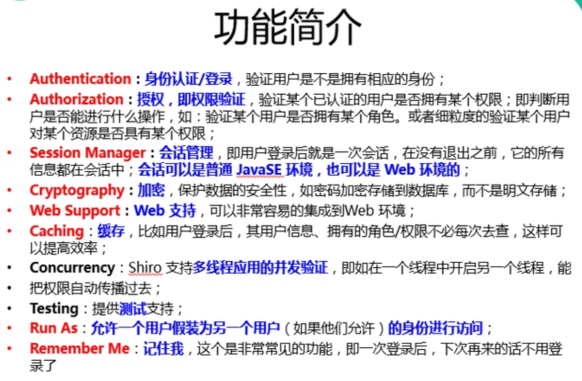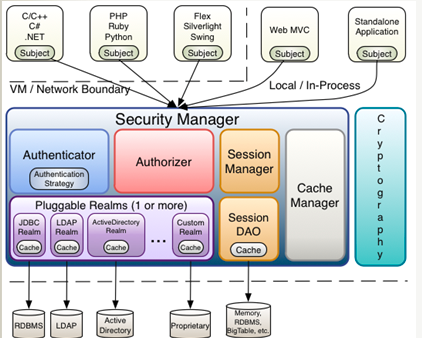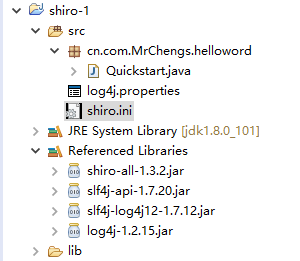shiro簡單入門介紹
阿新 • • 發佈:2018-11-19
shiro是apache的一個java安全框架
可以完成認證,授權,加密,會話管理,基於web繼承,快取等
功能簡介:


從外部來看:

shiro架構
Subject:主體,代表了當前“使用者”,這個使用者不一定是一個具體的人,與當前應用互動的任何東西都是Subject,如網路爬蟲,機器人等;即一個抽象概念;所有Subject都繫結到SecurityManager,與Subject的所有互動都會委託給SecurityManager;可以把Subject認為是一個門面;SecurityManager才是實際的執行者;
SecurityManager
從內部看:

Subject:主體,可以看到主體可以是任何可以與應用互動的“使用者”;
SecurityManager:相當於SpringMVC中的DispatcherServlet或者Struts2中的FilterDispatcher;是Shiro的心臟;所有具體的互動都通過SecurityManager進行控制;它管理著所有Subject、且負責進行認證和授權、及會話、快取的管理。 Authenticator:認證器,負責主體認證的,這是一個擴充套件點,如果使用者覺得Shiro預設的不好,可以自定義實現;其需要認證策略(Authentication Strategy),即什麼情況下算使用者認證通過了; Authrizer
下載地址:
http://shiro.apache.org/download.html
HellowWord:


package cn.com.MrChengs.helloword;
/*
* Licensed to the Apache Software Foundation (ASF) under one
* or more contributor license agreements. See the NOTICE file
* distributed with this work for additional information
* regarding copyright ownership. The ASF licenses this file
* to you under the Apache License, Version 2.0 (the
* "License"); you may not use this file except in compliance
* with the License. You may obtain a copy of the License at
*
* http://www.apache.org/licenses/LICENSE-2.0
*
* Unless required by applicable law or agreed to in writing,
* software distributed under the License is distributed on an
* "AS IS" BASIS, WITHOUT WARRANTIES OR CONDITIONS OF ANY
* KIND, either express or implied. See the License for the
* specific language governing permissions and limitations
* under the License.
*/
import org.apache.shiro.SecurityUtils;
import org.apache.shiro.authc.*;
import org.apache.shiro.config.IniSecurityManagerFactory;
import org.apache.shiro.mgt.SecurityManager;
import org.apache.shiro.session.Session;
import org.apache.shiro.subject.Subject;
import org.apache.shiro.util.Factory;
import org.slf4j.Logger;
import org.slf4j.LoggerFactory;
/**
* Simple Quickstart application showing how to use Shiro's API.
*
* @since 0.9 RC2
*/
public class Quickstart {
private static final transient Logger log = LoggerFactory.getLogger(Quickstart.class);
public static void main(String[] args) {
// The easiest way to create a Shiro SecurityManager with configured
// realms, users, roles and permissions is to use the simple INI config.
// We'll do that by using a factory that can ingest a .ini file and
// return a SecurityManager instance:
// Use the shiro.ini file at the root of the classpath
// (file: and url: prefixes load from files and urls respectively):
Factory<SecurityManager> factory = new IniSecurityManagerFactory("classpath:shiro.ini");
SecurityManager securityManager = factory.getInstance();
// for this simple example quickstart, make the SecurityManager
// accessible as a JVM singleton. Most applications wouldn't do this
// and instead rely on their container configuration or web.xml for
// webapps. That is outside the scope of this simple quickstart, so
// we'll just do the bare minimum so you can continue to get a feel
// for things.
SecurityUtils.setSecurityManager(securityManager);
// Now that a simple Shiro environment is set up, let's see what you can do:
// get the currently executing user:
//獲取當前的subject
//呼叫SecurityUtils.getSubject();
Subject currentUser = SecurityUtils.getSubject();
// Do some stuff with a Session (no need for a web or EJB container!!!)
//測試使用session
//首先獲取session:currentUser.getSession();
//
Session session = currentUser.getSession();
session.setAttribute("someKey", "aValue");
String value = (String) session.getAttribute("someKey");
if (value.equals("aValue")) {
log.info("--->Retrieved the correct value! [" + value + "]");
}
// let's login the current user so we can check against roles and permissions:
//測試當前使用者是否已經被認證,即是否已經登陸
//呼叫subject的isAuthenticated()
if (!currentUser.isAuthenticated()) {
//把使用者名稱和密碼封裝為UsernamePasswordToken物件
UsernamePasswordToken token = new UsernamePasswordToken("lonestarr", "vespa");
token.setRememberMe(true);
try {
//執行登陸
currentUser.login(token);
}
//若沒有指定的訊息,則shiro會丟擲UnknownAccountException異常
catch (UnknownAccountException uae) {
log.info("There is no user with username of " + token.getPrincipal());
}
//若賬戶存在,但是密碼不匹配則丟擲IncorrectCredentialsException
catch (IncorrectCredentialsException ice) {
log.info("Password for account " + token.getPrincipal() + " was incorrect!");
}
//使用者被鎖定的異常
catch (LockedAccountException lae) {
log.info("The account for username " + token.getPrincipal() + " is locked. " +
"Please contact your administrator to unlock it.");
}
// ... catch more exceptions here (maybe custom ones specific to your application?
//所有認證時的異常父類
catch (AuthenticationException ae) {
//unexpected condition? error?
}
}
//say who they are:
//print their identifying principal (in this case, a username):
log.info("User [" + currentUser.getPrincipal() + "] logged in successfully.");
//test a role:
//測試是否有某一個角色
if (currentUser.hasRole("schwartz")) {
log.info("May the Schwartz be with you!");
} else {
log.info("Hello, mere mortal.");
}
//test a typed permission (not instance-level)
//測試是否具有某一個行為
if (currentUser.isPermitted("lightsaber:weild")) {
log.info("You may use a lightsaber ring. Use it wisely.");
} else {
log.info("Sorry, lightsaber rings are for schwartz masters only.");
}
//a (very powerful) Instance Level permission:
//測試使用者是否具備某一個行為
if (currentUser.isPermitted("winnebago:drive:eagle5")) {
log.info("You are permitted to 'drive' the winnebago with license plate (id) 'eagle5'. " +
"Here are the keys - have fun!");
} else {
log.info("Sorry, you aren't allowed to drive the 'eagle5' winnebago!");
}
//all done - log out!
//執行登出
currentUser.logout();
}
執行即可體驗shiro的簡單功能....
